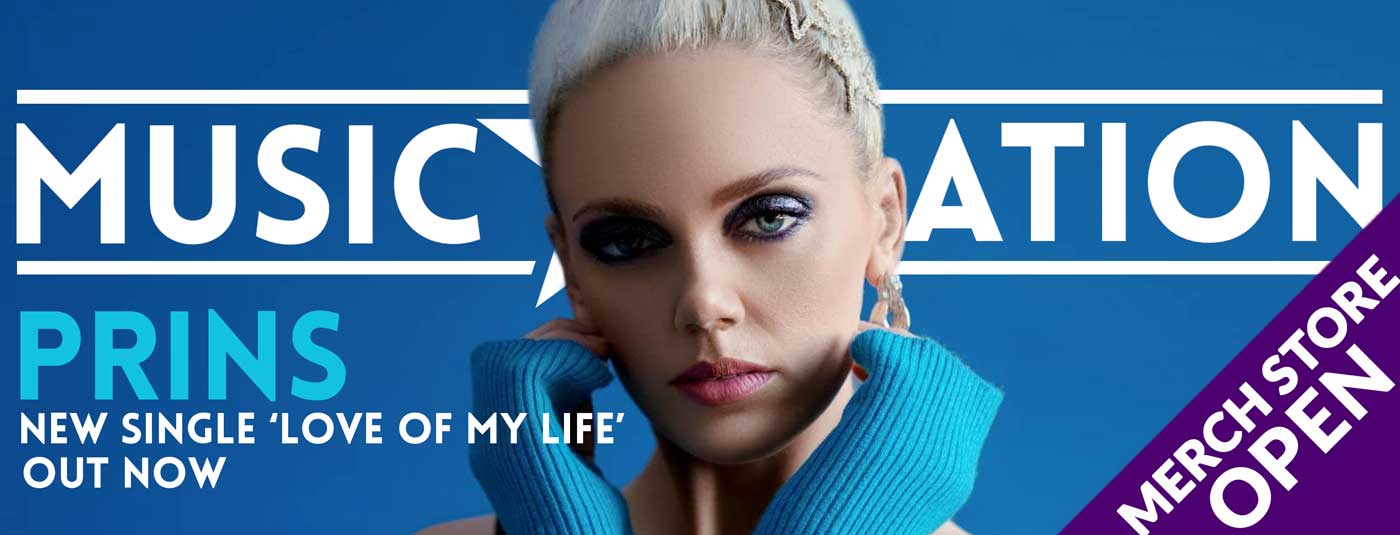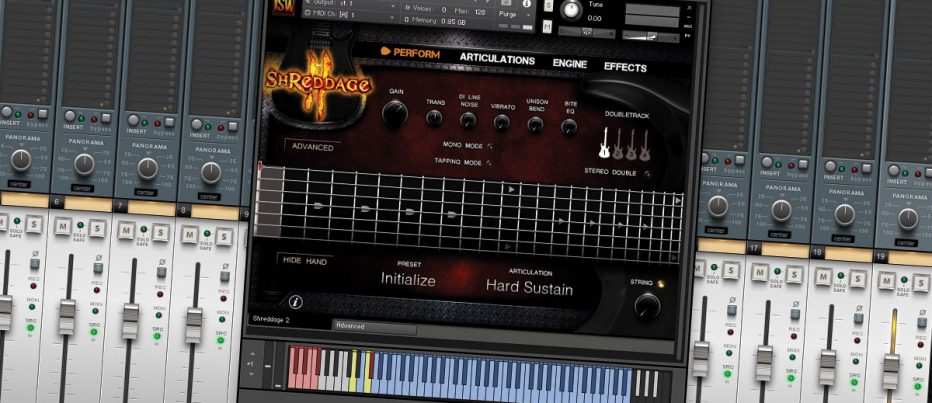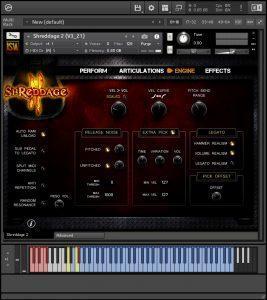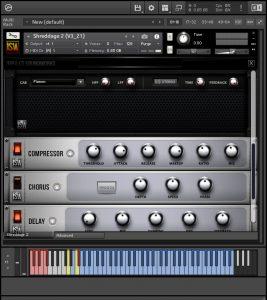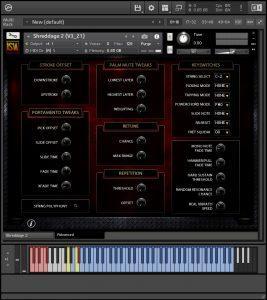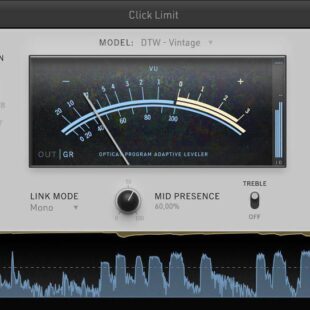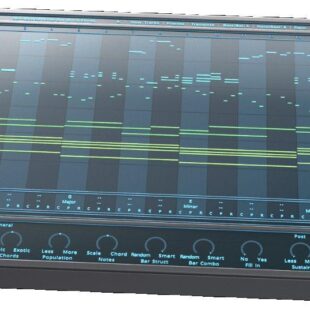Impact Soundworks Shreddage 2 – The Guitar Hero
Welcome to our first look at Impact Soundworks Shreddage 2: Absolute Electric Guitar, a dry-recorded 7-string guitar sample library squarely focused on the hard rock and metal genre.
Impact Soundworks has refreshed their 2010 original with this brand new variant featuring a cool new interface, scripting and a bunch of newly recorded samples added for good measure.
(Review updated March 2021) Guitar virtual instruments have come a long way since the early rather cheesy MIDI incarnations, and in a rather crowded market space Impact Soundworks has carved a strong following, so I’m eager to check out the software to see if my inner-Malmsteen can be realised in MIDI format.
Overview
Shreddage 2 is a virtual guitar emulator for the Native Instruments Kontakt platform (either free or full version). It is a dry recorded baritone Musicman 7-string guitar tuned to low G (!!) with fully mappable MIDI CC and articulation controls.
Single notes, chords and embellishment effects like pinch squeals, gliss and finger taps were recorded. The software includes re-amping and basic effects but also comes with a lite version of Peavey’s excellent ReValver software to create your own custom amp setups. You can, of course, use any 3rd party amp simulator software to get your favourite tone, such as Guitar Rig, Amplitude, TH3 etc.
Installation was a breeze, there is a downloader you can install, but we chose to manually download the compressed files and extract them with WinRAR. Drag and drop the library into the appropriate Kontakt root directory on your computer and fire up Native Instruments Access software to activate using your serial code and you’re away.
Fire it up, baby!
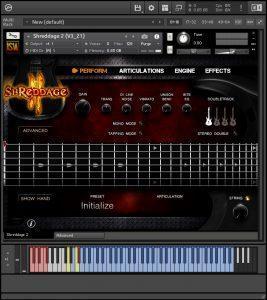 Shreddage 2 comes with a basic collection of effects which are actually only macro controls for the standard Kontakt internal effects. As usual, the compressor, delay and chorus are great, but the amp simulator is not so much. Strangely no reverb module is included, so you’ll need to either set one up as an AUX send or use a third-party plugin with Shreddage in doubletrack mode.
Shreddage 2 comes with a basic collection of effects which are actually only macro controls for the standard Kontakt internal effects. As usual, the compressor, delay and chorus are great, but the amp simulator is not so much. Strangely no reverb module is included, so you’ll need to either set one up as an AUX send or use a third-party plugin with Shreddage in doubletrack mode.
Really the best way is to avoid all that and use one of the many amp simulation plugins available, including the freebie ReValver that comes with Shreddage. Our mainstay at Music Nation is IK Multimedia’s Amplitude 4, with the Mesa Boogie Dual Rectifier being my go-to. We didn’t get a chance to try this, but re-amping a physical amp in your studio should be no different than any other recorded guitar track, so plenty of options available for tone.
Shreddage 2 features multiple picking modes, so you can stroke up, down or an oddly titled ‘economy’ mode which still plays down and up when it’s the same string, but if the software changes to a lower string it swaps to up and down if it swaps to a higher string you get down and up. Yeah, I know – huh? It’s hard to hear the consequence of this, but adding to the 4 round robins per note contributes to the overall humanising feel.
A nifty multi-tracking option allows you to use up to four instances of Shreddage, all assigned the same MIDI channel but separate outputs to your DAW for amazing width, and since each features its own round robbin effects and modulation controls, quite convincing results. I found great results using double-tracking directly into a stereo instance of Amplitude, which is a setup duel amp and cabs.
Since the strings we deeply sampled, the intonation is ever so slightly out with each, depending on where you play it on the fretboard – meaning choosing focused areas of the fretboard to play on results in completely different tones. Included is a nifty ‘Hand Size’ control which defines the area the software will attempt to focus, from broad to quite narrow.
I was immediately impressed by the initial feel and playability of the stock patch. Mostly it’s right on the money, with only a slight adjustment for my hamfisted keyboard playing. There are a LOT of articulations included, which will require some practice to build up your muscle memory for the keys, but mostly the basics are easy to remember.
Left to its own devices, Shreddage will merrily play notes from strings within range of the hand size you define, mostly. There is a ‘string’ control which allows you to force the software to focus on a specific string of your choosing, however, this is velocity triggered, and since there are slight tuning differences between strings at higher pitches due to intonation as mentioned, the pitching can be quite noticeable when the software bounces between locations.
The included collection of playstyle effects is excellent, most of which I can’t name, but you have your dive bombs, squeals, palm mutes, up and down slides, pick along the string scrape and whammy bar fx – the only thing I was bummed it didn’t have is Steve Stevens ray gun effect! I’m joking a little bit, there are tons of the usual embellishments – anything really crazy you’ll need to pay a real guitarist for I’m afraid.
Road Test
I dropped Shreddage into an archived rock track I had and recreated the original solo as best I could. The results were quite good, though it took some time to achieve. The song I played through probably three takes which took about 5minutes. Programming with Shreddage took probably 2 hours. It’s no fault of the software, it just takes time to program the MIDI just right and apply all the correct feel elements.
One of the trickier aspects for me was applying the correct amount of pitch and modulation wheel vibrato. When you play, you naturally vibrate the strings and can feel the tension through your fingers, a kind of tactile feedback as to how far to bend and how much play you get for wobbling, you don’t get that at all with the piano. It took many passes to get the feel even close, in the end, I resorted to editing the raw MIDI track in piano roll view. Though the pitch wheel actually sounds quite convincing, it’s all too easy to push too fast or unrealistically bend at the same time a vibrato, only subtle movements are required.
Again, this is not a Shreddage complaint, it’s a computer MIDI issue as I’m trying to replicate a stringed instrument with an 88-note weighted piano controller – your square box, round hole scenario.
So yes, I was able to satisfactorily replicate my physical solo with the MIDI version, in fact, if I’m honest, it sounds better thanks to all the extra processing and effects available. I think to get to a stage where you can play in new solos on the fly that contain all the correct human elements and feel will take as much practice as the real instrument – this is no magic pill fix I’m afraid.
There are no looped notes here, and they sustain for a good amount of time – around 20-23 seconds on average, more than enough time to smash out a power chord while you hold those horns to the gods of rock.
I think I’ll prefer to play the real guitar for solos while I have the inspiration fresh in my head, then to replicate it with Shreddage with all the cool-ass re-amping and effects available when I have time. There are many benefits to using MIDI guitar, for instance, tempo correction, key changes, quantizing, and groove randomising with software like Reason’s groove track certainly make the MIDI option a solid option for producers, so I’m definitely sold on the concept – but mostly, with me at least, I need the least amount of technology in my way when my brain is in create mode.
Conclusion
Having not used the previous versions of Shreddage I have been pleasantly surprised with the playability and workflow. The style is clearly targeting the metal players and might look a little out of place in your jazz or folk arrangement, but nevertheless, it does the job and provides all the controls you’ll need.
Shreddage 2 is an interesting product. Clearly, it’s designed and coded very well by people who understand guitars. My initial hopes of easily performing face-melting solos and slinky rhythmic grooves were not to be. This is an instrument that requires serious practice to come close to the real deal. Fortunately, all the right stuff is here, everything you need…except the talent (in my case).
Ironically, I think you need to be a fairly competent guitarist to get the most out of Shreddage – there are idiosyncrasies with guitars when playing you just need to know how and when to apply. You can, of course, bash out some chords and cobble together some simplistic stuff with no problem, but if you’re looking to produce serious results to convince fans, most of whom are probably excellent guitarists, you have some work cut out for you.
At $139 this is about the same price as the competition, but still reflects very good value considering the amount of content you get here. If you have absolutely nothing else, you’ll need to factor in a copy of Amplitude, TH3 or the like which could add a further $200 to your credit card, but that’s what’s required to create the big-sound results (though do a little Google search for TSE Audio).
Yes, it sounds amazing, yes you can sound like Dragon Force if you want and yes, I do really like this instrument – but secretly I am a little pleased computers still can’t replace guitarists just yet with a click of a button (RIP Drummers).
As an addition to, or total replacement for your actual guitar recordings, Shreddage 2 is a massive step up over anything that came before it. It is a complicated instrument to perform authentic parts with, so don’t go in thinking this is a quick fix – but the end results are well, well worth the time and effort.
Check Impact Soundworks site for this and other virtual libraries right here www.impactsoundworks.com
Like the review? Shout us a cup of coffee!
